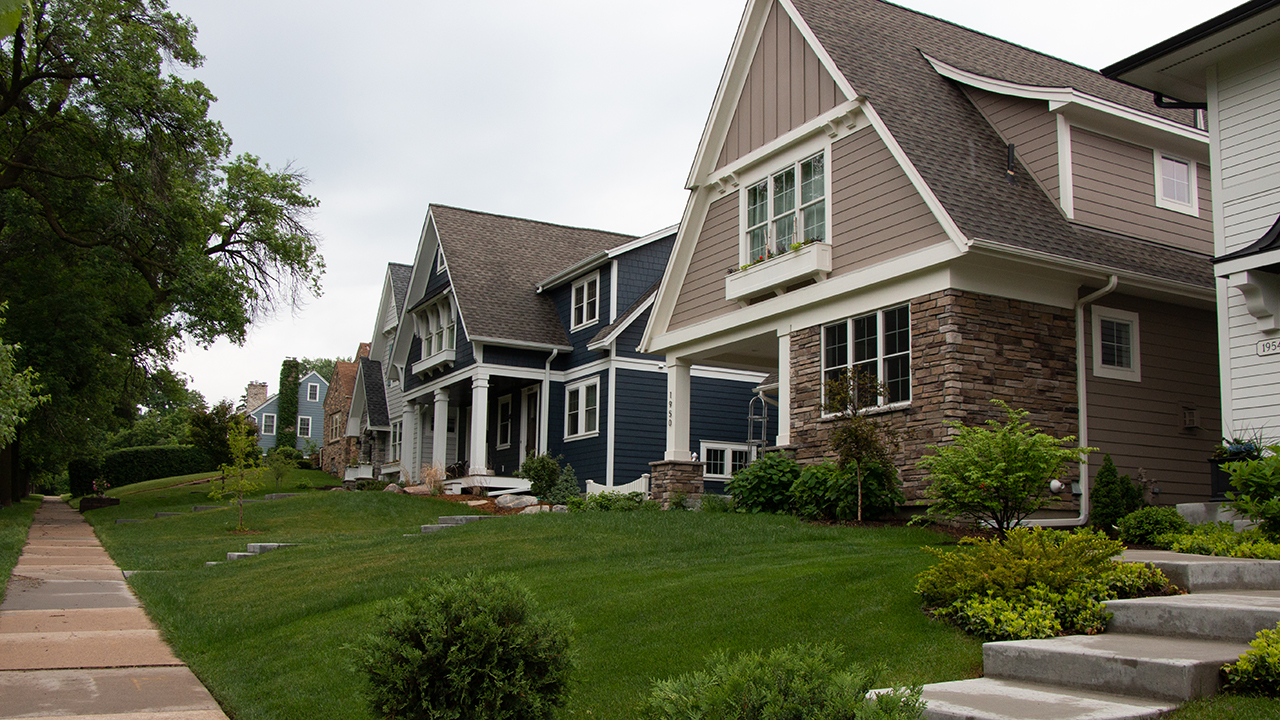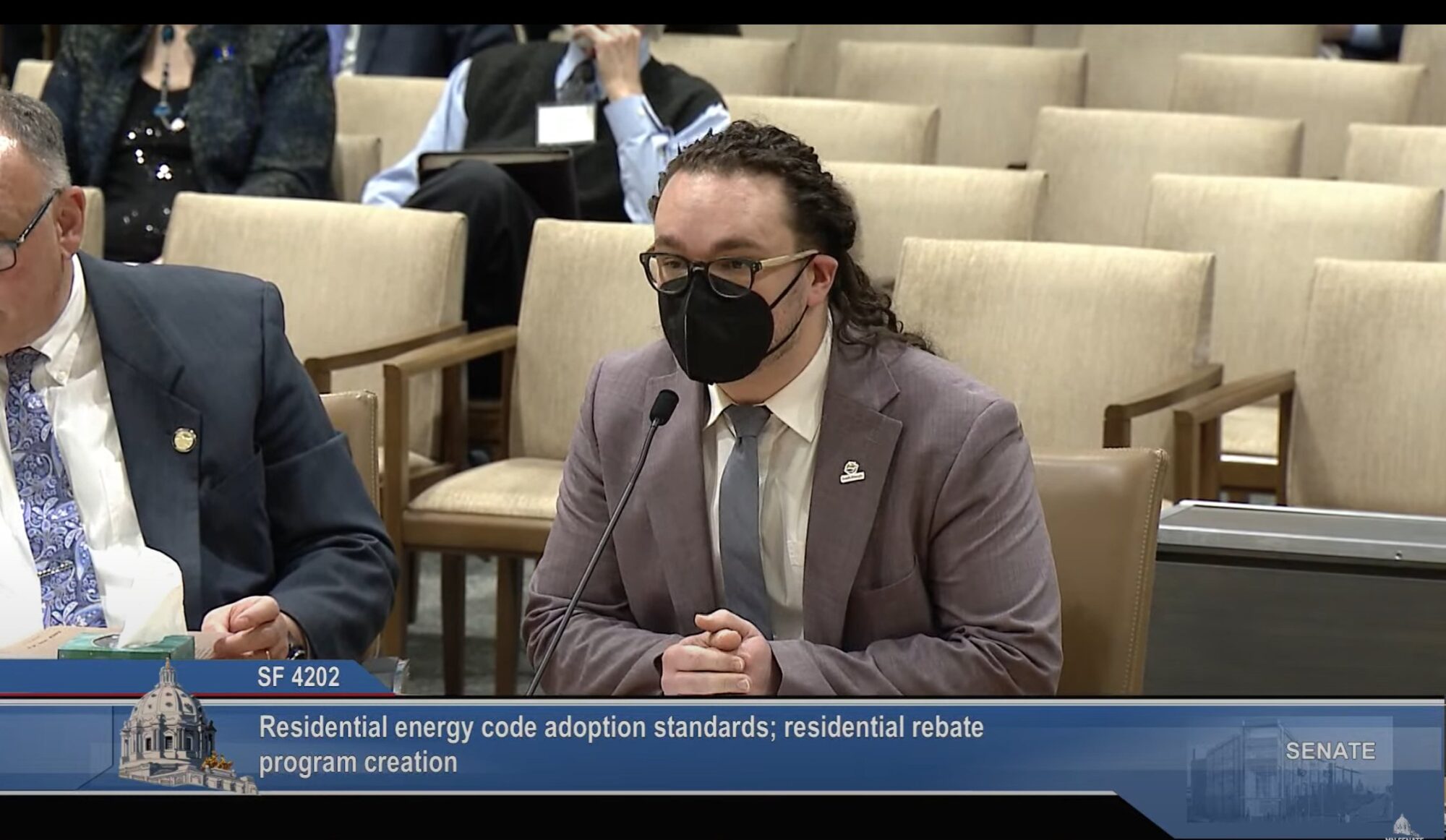
In the Land of 10,000 Lakes, there’s one thing all Minnesotans can wholeheartedly agree on: the desire to trim down those monthly energy bills during our frigid winters and muggy summers. Whether you’re nestled in the frosty reaches of northern Minnesota or weathering the windy fields to the south, the way we construct our homes holds the key to unlocking substantial savings on our energy expenses.
By constructing buildings to be more energy-efficient, Minnesotans can enjoy lower monthly energy bills and pave the way for a cleaner, healthier future, too. That’s important, because the greenhouse gas emissions from Minnesota’s residential buildings have surged 14% over the past 15 years, largely fueled by the natural gas that many Minnesotans use to heat their homes and power their appliances.
Since the way we build our homes has an outsize impact on its energy use for decades to come, Fresh Energy is advocating for a smart, long-term policy for how homes are built across the state. To that end, we and several partners are supporting a new bill at the Minnesota Legislature, Senate File 4202 authored by Senator Mitchell and House File 4242 authored by Representative Kraft, to accelerate efficiency improvements in Minnesota’s residential energy code to improve the energy efficiency of new homes to save homeowners and renters money, improve health in our buildings, and lower greenhouse gas emissions from the residential buildings sector. The bill also supports projects that go well beyond the minimum requirements in the building code by offering a rebate for energy rating services needed to attain the Department of Energy’s rigorous Zero Energy Ready Home certification.
But what are building codes, and how can we update them to reduce energy waste and greenhouse gas emissions? Keep reading to learn how we’re ensuring Minnesota can construct climate-smart homes to help us thrive for generations to come!

What are building codes?
Building codes establish the minimum standards for a building’s quality, safety, energy use, and construction. Since constructing a building is the best and often only chance to determine how much energy it will consume, building codes have an outside impact on how much energy we need to power our buildings across the state. That means the building code adoption process has significant impact on the climate- and human-impact of our buildings.
Constructing a building “to code” means that the building will meet the minimum state requirements, but only that. Building developers and owners can always construct buildings that are more efficient than the code requires, but never less efficient.
If you want a deep dive into what building codes are and how they affect our health and climate, read our blog post all about it!
Minnesota’s residential building code must support state climate targets
A carbon-free energy economy requires buildings that sip, not guzzle, energy. Minnesota’s historic 2023 legislative session passed many ambitious climate and energy goals, including a requirement for the commercial energy code to achieve 80% or greater reduction in annual net energy consumption by 2036.
While the commercial code includes larger multifamily housing projects, it does not cover smaller residential properties or single-family homes. Minnesota’s residential energy code lacks an energy savings target like the commercial energy code, which reduces the likelihood of meeting state climate targets and leaves residents of small and single-family buildings out of beneficial efficiency improvements.
Accelerating energy efficiency in Minnesota’s residential energy code will decrease energy waste, save consumers money on energy bills, and help Minnesota meet its climate goals.
This proposed bill before the Minnesota State Legislature would require the Department of Labor and Industry to adopt a 2038 residential energy code that achieves an 70% reduction in energy use compared to the 2006 baseline. By requiring some progress with each code update until 2038, this bill also provides predictability and avoids delaying needed improvements until the 2038 residential energy code.
Energy-efficient housing will save money, reduce emissions, build resilience
Constructing residential buildings to higher standards brings a myriad of benefits to Minnesotans across the state.
First, energy efficient homes save homeowners and renters money. The Federal National Mortgage Association (Fannie Mae) found that mortgages only accounted for about 30% of the total cost of housing over the typical seven-year homeownership cycle. In fact, utility bills are the highest non-mortgage cost to homeowners.
Improving home energy efficiency reduces monthly expenses and provides plenty of non-energy benefits, too, including improved comfort, health, and safety benefits, like better indoor environmental quality. Building homes to a higher standard will also increase resilience to extreme weather events by preserving comfortable and safe living conditions for longer during an outage.
Reducing energy use in residential buildings will also help reduce strain on the electric grid during extreme temperature events. This in turn saves customers money by reducing how much the grid needs to grow to keep up with demand from electrification.
A better building code also sets a level playing field so that efficient, healthy homes are the norm for all new construction, not just an upgrade for the wealthy or highly informed homeowners and renters.
Establishing a Residential Energy Rating Rebate Program
One of the most rigorously efficient and high-performing building certifications is the U.S. Department of Energy’s Zero Energy Ready Home (ZERH) program. Homes that meet ZERH standards are so energy efficient that a renewable energy system could offset most or all of the home’s annual energy use. Because they require third-party verification by a professional energy rater, they provide confidence to residents that homes are comfortable, healthy, and durable.
ZERH homes are increasingly popular in the U.S., but many Minnesotans—especially those living outside the Metro area—don’t have access to certified energy raters to help them meet ZERH standards. Fresh Energy is helping to provide thought leadership for and advance legislation that would cover the cost of energy rating services for new homes that meet ZERH certification standards, helping more Minnesotans opt-in to the benefits of energy-efficient homes.
To remove barriers to cutting edge new homes, this bill also supports those who go above and beyond Minnesota’s residential energy code by covering the cost of energy rating services for new, ZERH-certified homes.
The Residential Energy Rating Rebate Program would:
- Create a new program offering full reimbursement of energy rating services required for ZERH certification, including:
- Up to $5,000 per single family home, and
- Up to $2,500 per unit in multifamily housing, up to $15,000 per building.
This rebate will especially support builders in Greater Minnesota, where there are few to no energy raters, leading to higher costs when hiring a rater who must travel from the Twin Cities.
Finally, this investment will also bring more federal incentives to the state, especially in Greater Minnesota. The federal 45L tax credit offers $5,000 per new ZERH home, but hiring a Metro-area energy rater quickly uses much of this incentive. By providing full reimbursement across the state, this policy would ensure that rural residents can benefit just like Metro-area residents from high-performing, energy-efficient homes.
What’s next
Minnesota’s commercial and residential buildings contribute to roughly 40% of our state’s greenhouse gas emissions—and that number continues to rise. Accelerating efficiency in the residential energy code is crucial to slowing and reversing this trend while prioritizing the health and pocketbooks of all Minnesotans by building the next generation of energy-efficient, resilient buildings.
Fresh Energy continues to take action to improve building energy codes for health, savings, and climate. We advocate for stronger energy codes in the state’s Commercial and Residential Code update process and advance better building codes and code adoption processes at the State Legislature.
Stay tuned for more residential building code updates to come!
